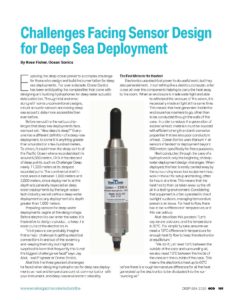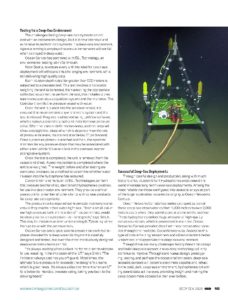Exploring the deep ocean presents a complex challenge for those who design and build instrumentation for deep sea deployments. For over a decade, Ocean Sonics has been anticipating the complexities that come with designing and building hydrophones for deep water acoustic data collection. Through trial and error, along with some unconventional designs, robust acoustic sensors are making deep sea acoustic data more accessible than ever before.
Before we outline the various challenges that deep sea deployments face, we must ask, “How deep is deep?” Everyone has a different definition of a deep sea deployment, to some it is anything greater than a hundred or a few hundred meters. To others, it could mean the deep points of the Pacific Ocean where recorded depth is around 6000m. To some it can be the deepest of deep points, such as Challenger Deep, nearly 11,000m at its deepest recorded point. The continental shelf in most areas is between 1000m and 2000m, since deployments at this depth are generally regarded as deep water deployments by the larger ocean tech industry, we will define a deep water deployment as any deployment at a depth greater than 1000m.
Preparing sensors for deep water deployments begins at the design stage. Before electronics can enter the water, it is imperative to design a product to keep the water out and the electronics in.
“Most people can probably imagine that a major challenge is getting electrical connections in and out of the assembly and keeping them dry, but might be surprised to learn that frequently this is not the biggest challenge we face!” Says Jay Abel, Lead Engineer at Ocean Sonics.
Abel lists the three greatest challenges he faced when designing hydrophones for deep sea deployments as heat and temperature control, communication with your instrument, and deep sea environment reliability.
The first meter is the hardest
Electronics use electrical power to do useful work, but they also generate heat. In something like a desktop computer, a fan blows air over the components helping to carry the heat away to the room. When an enclosure is made watertight and able to withstand the pressure of the ocean, it is necessarily made airtight at the same time. This means that heat generated inside the enclosure has nowhere to go, other than to be conducted through the walls of the case. In order to reduce the generation of excessive heat, materials much be sourced with efficient strength and anti-corrosion properties that are also poor conductors of heat. Ocean Sonics uses titanium in all sensors intended for deployment beyond 900m specifically for these purposes.
Heat conducted through the case of a hydrophone is only the beginning of deep water deployment design challenges. When deployed, the heat is easily carried away by the surrounding water, but equipment must work in the air for setup and testing, often for hours at a time. This means that the heat has to then be taken away by the still air in a testing environment. Considering that equipment is often operated in direct sunlight outdoors, managing temperature presents an issue. For heat to flow, there has to be a difference in temperature, and this can add up.
Abel describes this process “Let’s say we are outdoors and the temperature is 30 C. For simplicity sake, assume we need a 15 C difference in temperature for enough heat to flow to keep the electronics at equilibrium.” Abel continues, “We don’t just need 15 C between the outside of the case and surrounding air, we also need 15 C between the inside of the case and the outside of the case. This means the electronics heat up to 60 C before there is enough temperature difference for all the heat generated by the electronics to be dissipated into the surrounding air.”
*For reference, the maximum usable temperature for Lithium batteries is 60 C.
This process places a limit on how much power can be used in a case of a particular size, so just making everything small isn’t enough; it must also be low power. Ocean sensor deployments of all depths are trending toward lower power. Ocean Tech engineering teams around the globe are consistently grappling with how to reduce the power of their deployments, especially those that are remote, autonomous or deep. With the added complexity of a deep sea deployment, power management presents a significant challenge. The potential for an instrument to overheat is present, but there is also the issue of maintaining a low power, quiet environment for a sensitive digital acoustic sensor, like an icListen Smart Hydrophone, to coexist with analogue instruments.
Is This On?
For most land-based devices we take for granted that there is a display of some kind, or at least a power indicator. But what if the entire case is solid titanium? To withstand the pressure of the deep ocean, a plastic window can’t be placed on a product and be expected to survive at the intense pressure levels of a deep sea deployment.
To bypass this issue, a haptic feedback in employed. This means that your instrument will vibrate, similar to a cell phone, when the unit is receiving power and ready to configure and deploy.
Through a series of “buzzes” we can indicate when the unit powers up, shuts down, or encounters an error condition. The icListen Smart Hydrophone communicates with the user in a 2-way fashion. The user plugs in a cable and the instrument will vibrate to give an all clear, or uses a different pattern if there is a problem.
Users can connect electronically to the product’s control panel via Ethernet or other means but it’s not always convenient to do this. Employing haptic feedback build reliability into the process of deploying hydrophones, while also ensuring the case maintains its integrity in the deep sea.
Maintaining a Watertight Seal
Keeping the water out of the instrument is a primary goal of the designer. Even a small quantity of water can cause the instrument to fail, and permanent damage.
Electrical connections require that a hole be drilled into the vessel and a connector added.
The designer must ensure that adding connectors does not introduce leaks. As depths get greater, more robust (and costly) connectors are required. The method for assembly of the vessel is critical for deep water deployments.
Normally end caps are plugged into a tube to seal the vessel. The contents of the vessel are attached to one of the end caps. There are many end cap designs used for deep water. Some are better than others as depth increases.
Ocean Sonics uses optimal seal designs for our pressure vessels. Equally important is ‘hygiene’ during assembly. Seals normally use O rings, which must be very clean and lightly lubricated during assembly. Any material, such as dust or lint, that contacts the O ring can compromise the seal. Great care is required when assembling instrument vessels for deep water.
Testing for a Deep Sea Environment
The challenges facing deep sea deployments do not end with an instruments design. As it is labour intensive and expensive to perform deployments in a deep sea environment, rigorous testing is employed to ensure instruments will not fail when deployed in deep water.
Ocean Sonics has partnered with ESL Technology, an environmental testing lab in Dartmouth, NS, to ensure every unit intended for deep sea deployment will withstand this challenging environment, while still delivering high quality data.
Each icListen depth rated for greater than 900m is subjected to a pressure test. This test involves an operator weighing the unit to be tested, then selecting the appropriate calibrated equipment to perform the test, this includes a pressure transducer, data acquisition system and thermometer. The Operator then fills the pressure vessel with water.
Once the unit is placed into the pressure vessel, it is ensured that no air remains anywhere in the system and the test is initiated. Progress is observed using LabView software, which displays a real time graph and instantaneous pressure value. When no leaks or deformation occur, and the ramp will show a straight line, slope of which is dependent on the rate of pressure increase, maintained at or below 35 psi/second. Once a pressure plateau is reached and held, the operator monitors for any pressure drops that may be associated with either a test article failure or a leak in the pressure reactor piping/valve system.
Once the test is completed, the unit is removed from the vessel and dried. A post-inspection is completed where the unit is re-weighed. The weight before and after testing are compared and used as a method to determine whether water invasion into the hydrophone has occurred.
Darren Smith and his team at ESL Technologies perform this pressure test for all icListen Smart Hydrophones destined for use in a deep water environment. They provide a similar procedure for a number other clients with various products for deep sea deployments.
The pressure tanks required some periodic maintenance to ensure they maintain their water-tight seal. “Even a small leak in our high pressure tank, in the order of 1 cc per minute, would be clearly visible on a pressure – vs – time graph.” says Smith. This may be mistaken as item under testing, or IUT, leaking rather than an issue with the pressure tank.
Ocean Sonics takes great care to ensure that each hydrophone intended for a deep water deployment is carefully designed and tested, but even the most meticulously designed deep water instruments can fail.
“It’s always exciting when a client performs a test to ultimate failure, resulting in the implosion of the IUT.” says Smith, “The implosion always catches you off guard. Most times, the ultimate failure pressure far exceeds the designer’s dreams, which is great news. It’s always a disappointment when an IUT fails below its intended pressure rating, back to the drawing board.”
Successful Deep Sea Deployments
Through careful design and production, along with much trial and error, icListen Smart Hydrophones exist around the world in various long term deep sea deployments. Among the most notable are those configured into acoustic arrays as part of the large-scale observatories belonging to Ocean Networks Canada. Ocean Networks Canada has nodes deployed as part of these deep sea observatories from 1000m to over 2000m deep where they spend years at a time on the seafloor. These hydrophones collect huge amounts of high quality ocean sound data, which is processed in real-time. Ocean Networks Canada provides data from these ocean observatories through their website, OceanNetworks.ca. Access to this type of data is helping researchers and citizen scientists better understand and appreciate the deep sea environment.
Though there are many challenges facing those that design and build deep sea sensors, the existing technology will only continue to improve. Through continuous design, prototyping, testing, and perhaps the occasional implosion, deep sea acoustic sensors will become even more capable and robust. In the cold, dark, deep sea environment, hydrophones collecting sound data act like eyes, providing insight and making the deep ocean more accessible.





